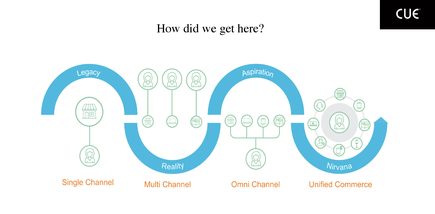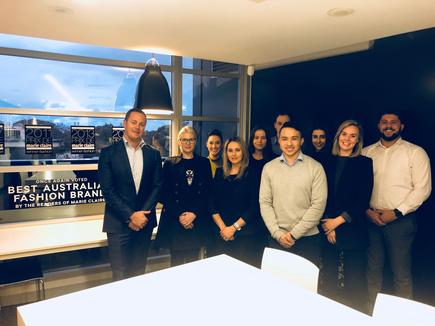
From a retail perspective, we have diluted the channel conflict.
For retailers aiming for the nirvana of omnichannel experience, Shane Lenton has this to say.
“First and foremost, you can’t fake it,” says the chief information officer of Cue Clothing, which operates a chain of stores across New Zealand and Australia.
“There is no point offering customers ‘click and collect’ or whichever innovation it is if the underlying infrastructure and solutions are not in order,” he says.
If you are looking to innovate in your existing business, it is imperative to have the foundations in place and in decent shape, not sitting on legacy systems.
If not, he says, “You will be spending all your time putting out fires and distracting other parts of the business.”
“Once those foundations are there, research the market on what your competitors are doing. Understand consumer demands,” says Lenton.
Lenton speaks from experience.
The fashion retailer, whose brands include Cue, Veronika Maine and Dion Lee, has in recent years shifted from traditional bricks and mortar and forayed into online and offline channels.
It was a phased approach, says Lenton. It started with multichannel, online and offline. “These two channels ‘talked to each other’ to an extent but we were not providing a seamless experience to our customers,” says Lenton.
“At that point, we had so many pieces of integration and technology,” he says. “We were doing a lot of heavy lifting around our core platforms to facilitate it.”
“Our strategy was to bring these two together with an omnichannel strategy.”

Unified commerce approach
Today, he says, Cue has a unified commerce solution which provides a seamless customer journey across all their channels, whether in store or online.
“When people ask me what our online retail strategy is, from my perspective, it is simply a retail strategy. It is all one channel for us. That is what we worked very hard to achieve.”
He believes that Cue Clothing is leading in this unified commerce approach in New Zealand and Australia.
“We are offering a true unified commerce solution,” he says.
Cue opened its first store in Sydney’s Strand Arcade in 1968, introducing trend-driven and fashion forward styles in-store each week.
We have this strategy of ‘buy anywhere, fill anywhere’ regardless of the touch point where the customers come in, whether it is live chat, phone call or email.
Today, Cue is the largest local manufacturer of fashion in Australia with all designs originating from its head office in Sydney.
“Our point of different in the market is our modern designs, quality fabric and tailoring,” he says of the company, which remains Australian-owned.
Each design is produced in limited quantities, he says, and their clothes stand out due to sharp tailoring, statement prints and luxurious fabrics.
His strategy was to create a retail ecosystem that delivers a seamless combination of physical and digital channels that consider the needs of both their customers and the staff of their stores across New Zealand and Australia.
A key component of this strategy is a unified commerce platform that provides a single view of all customer and inventory data.
He explains this is the hub of all channels and touchpoints, allowing Cue to offer its customers “frictionless” and seamless experiences across physical stores, online, mobile, social and customer service channels.

Design-led
“We are a design-led business and we take this approach to our retail,” he says.
This means that every store does not get every style. “We do not mass produce, each store receives a curated range.”
“With the unified commerce solution, the customer can buy any item from any location in real-time.”
If they are online, they can have the item delivered to the store or their address.
In New Zealand, Cue does not have a distribution or fulfillment centre because all of their stock is held in stores.
“Every single product at New Zealand store level is available for instore and online customers.”
“You can buy them on the spot through our endless aisle solution, and pay your cart then and there.”
The customer will have options to get the items delivered at another store to be collected, or at home.
The product can come from another location, like a store in the South Island, but for the customer the process is seamless, he says.
The store will receive the order in the system. They will pack it for dispatch, and when that is registered in their point of sale solution, this triggers a booking with NZ Courier Post. The store has already created a label on POS printer.
“This is a real game changer, we haven’t had to add label printers for couriers.”

When people ask me what our online retail strategy is, from my perspective, it is simply a retail strategy. It is all one channel for us.
Lenton says this was made possible by working with the NZ Courier Post to accept the labels that they print and slip inside a clear plastic sleeve.
NZ Courier Post receives a booking into their system and their drivers get a notification when a package is ready to be collected. The packages are scanned and marked as collected into the POS.
The stores get a notification when they have an order. If they don't acknowledge in 10 minutes they get a reminder.
The customer care team has a dashboard of all these orders. If a particular store has an order that was not met, this is reflected in the dashboard and the store is contacted.
The customer care team also receives phone calls or email from customers seeking help.
Previously, a customer looking for a product will be directed to the store that will have it. Because the customer care team has visibility of the store inventory, they can now ask the customer if they would like to order and pay for it now. “They are a channel and another touchpoint where we are converting sales."
“We have this strategy of ‘buy anywhere, fill anywhere’ regardless of the touch point where the customers come in, whether it is live chat, phone call or email. The best thing is they are generating sales and ultimately, those sales are going to the store.”
The stores serve as distribution centres for fulfilment options such as 30 minute click-and-collect, store-to-door and three-hour deliveries nationwide. That means Cue gets its products to customers in the fastest, most cost-effective way possible, regardless of their location.

We are offering a true unified commerce solution
“Our stores are our competitive advantage,” says Lenton. “We have the footprint, we have a large inventory across our network. We are giving them a lot of opportunity to sell rather than sitting within one channel."
This ‘endless aisle’ capability enables customers to access the entire inventory across all stores from any channel or touchpoint, including 22-inch shoppable screens in their flagship stores.
“That is a huge competitive advantage over pureplays,” he says, referring to the online only clothing retailers.
“We allow one seamless transaction for the customer and our order orchestration is sitting behind the scene,” says Lenton.
Cue has also localised its website. There is a website for shoppers in Australia. Customers in New Zealand will be taken to the New Zealand site, where they will be shopping in NZ dollars. Outside ANZ, customers are brought to an international site.
From an online perspective, the customer has full access to every store, he says.
One of the important things they did was to implement an incentives system for each store and individual involved in delivering the customer experience.
“We push the online sales into stores so [that] the stores and the individuals who fulfil the sales from online also get rewarded,” says Lenton. “From a retail perspective, we have diluted the channel conflict.”
While delivering the best customer experience is the prime driver for the new systems, Lenton stresses the importance of ensuring any change will not add complexity to the staff.
“There is so much complexity in the world of retail and businesses these days,” he says. “So our goal was to streamline and make it seamless with one platform that the stores will be familiar with.”
“Our ultimate goal is to have a great outcome for the customer,” he says. “If we don’t take people on the journey, we can put all of the best technology in the stores but if they are not driving it or operating it the way it should be operated, it won't be successful and we won't get a good outcome.”
For instance, they started with click and collect solution, before rolling out other features to the stores. “We did not want to overwhelm them, they need to be comfortable with new initiatives.
“We have the data to support their compliance with it. Once we are happy with that, we work to evolve the solutions.”

Innovative partnerships
Cue utilises APIs to expose data and functions and easily plug in and deploy new services, channels and devices. This facilitates partnerships with startups and tech companies outside the retail industry.
For instance, Cue now accepts WeChat and Alipay payment services in their standalone stores.
“The key opportunity here is we can market to potential Chinese customers before they even step on a plane,” he says.
“We ran a 10 per cent off promotion where the Alipay users can download a coupon on the platform, and in May we had 24,000 downloads.”
He says Chinese consumers prefer these payment options over credit cars, as over 65 per cent of all payments in China is now done via Alipay,followed by WeChat pay.
“We have seen some amazing results with the average transaction from a customer using these payment methods being double that of other payment options.”
Digital technologies share a common feature with fashion; both are ever changing, constantly evolving.
For Lenton, this means part of his role is continuous research, keeping tracks of developments across the globe.
He attends a lot of industry events, mostly in retail, but also digital and emerging technologies.
He watches what vendors are pitching at these events on emerging technologies. He observes on a global scale what other retailers and businesses in general are doing.
“I look at how technology is applied to the way we live these days, then from my perspective, I take on a retail funnel to that technology. And from there, understand whether there is an opportunity for the business."
For instance, he notes 70 percent of website traffic comes from mobile devices.
Five years ago, their big focus was on their desktop website. But for the past 18 months, they have been optimising the mobile site and understanding trends of what users want.
 Credit: Dreamstime
Credit: Dreamstime Cue is also investing in AI, machine learning and mobile platforms to provide even more personalised customer experiences. It recently launched personalised e-receipts for in-store purchases that include targeted product recommendations.
“My approach to new technology in retail is don’t do it for the sake of doing it. I am always looking to create a better experience for the customer and not a gimmick.”
“AI and machine learning, is something we are excited about,” and which they have introduced in the website.
The technologies are behind the products recommended in the website and based on customers’ behaviour on the website and their CRM data.
“Because we have single view of customer data, we are recommending products specifically to them.”
Through their marketing automation platform they also inject some recommendations into the communications they send to customers.
Store customers have the option to choose a printed receipt or a digital receipt.
Customers are also asked when they open their email if they would like to answer an NPS survey and rate the store.
There is also the time optimisation. “We are not only personalising content, we are releasing it a specific time where you as an individual are most likely to engage with the communication.”
Today, customers can also upload a screenshot of their favourite look. It could be from an Instagram post or a blog, and they will know whether Cue has similar products to match.
This is done through technology provided by Alibaba Cloud.
"We work with them utilising their API, putting our technology together so all of our images from our weekly products get uploaded on the fly," says Lenton. "If someone submits a photo or a screenshot we can get back to them to display similar matches. Or, it would inform the customer that unfortunately they could not find a match.
“When people are consuming technology in everyday life, it is imperative in business that we replicate what they're doing across to our specific situations.”
At the same time he is looking at evolution of things like voice search.
He smiles when asked if Siri will soon be able to order a jacket from Cue.
“It can’t today, but it’s not to say it won't be a possibility in the not too distant future.”
From IT director to CIO-plus
Lenton has been CIO at Cue for nearly eight years. He joined Cue as an IT manager, and stepped up to CIO after two years.
Prior to his role at Cue Clothing, Lenton held various senior IT positions at organisations such as Tricom Equities, AMP Capital Investors, St George Bank, Commonwealth Bank, British Sky Broadcasting Group (BSkyB) and JCDecaux.
Today, his responsibilities include overseeing all aspects of IT and digital, both strategic and operational. It is a CIO-plus role, as he holds responsibilities for what would typically be assigned to the chief digital officer, such as e-commerce, members’ programmes and CRM.
He reports to the managing director, and works closely with the chief operating officer as well as the brand and marketing managers.
He has a second in command, the IT manager who is also chief information and security officer. His team members include a senior software developer, a systems administrator and help desk office support person.
In the e-commerce and digital team, there is a commerce manager with two reports and a CRM manager.
“Given the size and complexity of our business we are very lean but we have a very motivated, multi-skilled team,” he says.
Lenton says majority of their IT infrastructure - including Microsoft, VMware, Citrix, storage and switches - is managed internally.
“One of the main advantage is agility,” he says.

No ideas are silly ideas… it is important to champion that
"From a technical perspective we are not having to rely on third parties. We can make decisions quickly. It’s also an opportunity for our team to get great experience and to develop their technical skills in these core technologies”.
“We have a provider that assists with the management our network and firewalls and have some key partners," he says. "One provides and supports the retail management (unified commerce) platform; and another delivers the product lifecycle solutions used for the management and development of the production of our garments."
He also explains that the organisation has a flat structure. “What they can learn within the business in one year, may have taken them five years to learn in another business, or in larger IT departments.”
“It is a remarkable opportunity for them but at the same time we expect a lot from our staff. It is a win-win for our teams as well as [the] business,” he says.
He says they cross train staff as much as they can.
He says when he hires team members, he tells them that one of their perks is the company’s support for continuous learning.
As such, he ensures all of this team members undertake a raft of courses, and these include certifications, video-based training, correspondence courses, offsite courses and hands on development.
“The team is constantly upskilling, both from doing and seeking opportunities to learn and study.”
“For IT and digital, there is no one in the team that doesn’t get the opportunity to study and grow and evolve through their career. And that is very much by design,” says Lenton. “Our strategy is to make sure everyone is motivated, and everyone is growing their skills.”
He encourages collaboration across the technology and digital teams. Their office has an open floor plan, enabling the teams to work closely together.
“There is a lot of crossover and support and backfilling when needed. It creates outcomes because everyone is working so closely together, it means we have agility and skill to get things to market.”
As he points out, “You are only as good as the teams that work with you.”
“They need to feel comfortable, and respected. The fact you have got their back, you need to be constantly be working with them to improve their situation and grow them within the business, and beyond the business.”
“That is important as well, that you don’t hold them back,” says Lenton.
“Look after and really mentor the people you have now in the business.
“No ideas are silly ideas… it is important to champion that.”

Get the latest on digital transformation: Sign up for CIO newsletters for regular updates on CIO news, career tips, views and events. Follow CIO New Zealand on Twitter:@cio_nz
Send news tips and comments to divina_paredes@idg.co.nz @divinap
Join the CIO New Zealand group on LinkedIn. The group is open to CIOs, IT Directors, COOs, CTOs and senior IT managers.
